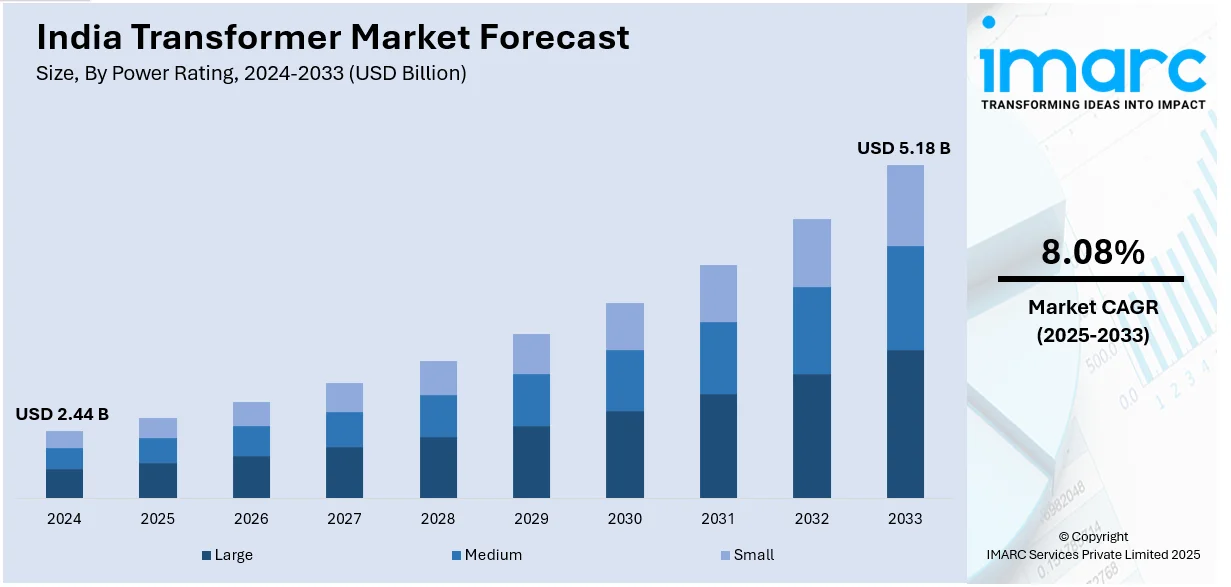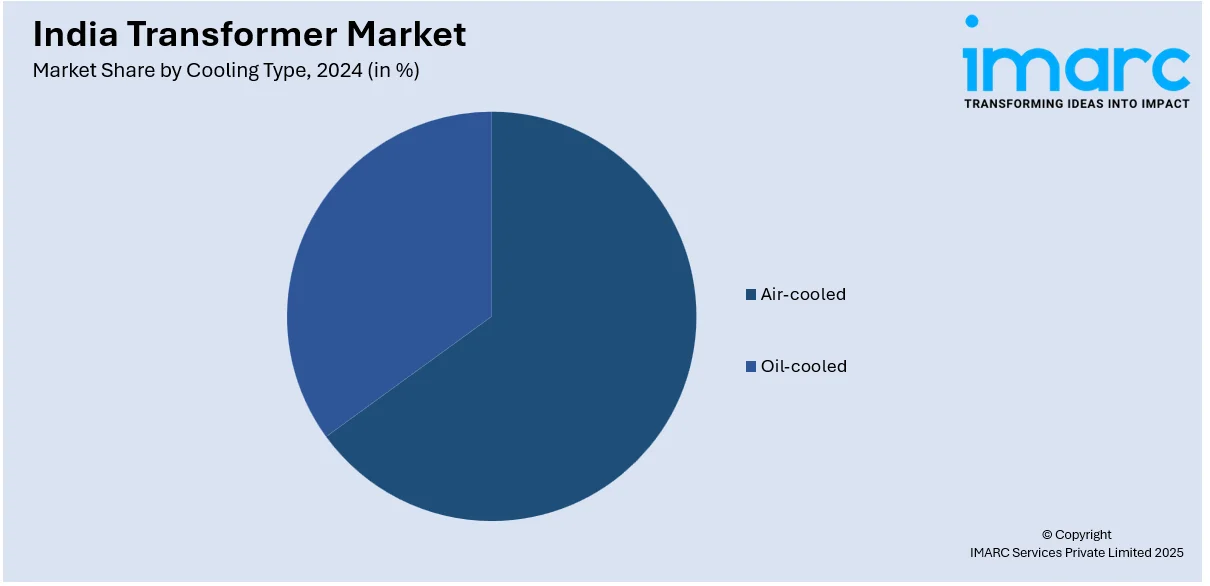
India Transformer Market Size, Share, Trends and Forecast by Power Rating, Cooling Type, Transformer Type, and Region, 2025-2033
India Transformer Market Overview:
The India transformer market size reached USD 2.44 Billion in 2024. Looking forward, IMARC Group expects the market to reach USD 5.18 Billion by 2033, exhibiting a growth rate (CAGR) of 8.08% during 2025-2033. Rising electricity demand, grid modernization, renewable energy expansion, rural electrification, government infrastructure projects, smart transformer adoption, increasing power transmission needs, “Make in India” initiatives, substation automation, and energy efficiency regulations are driving India's transformer market growth.
|
Report Attribute
|
Key Statistics
|
|---|---|
|
Base Year
|
2024
|
|
Forecast Years
|
2025-2033
|
|
Historical Years
|
2019-2024
|
| Market Size in 2024 | USD 2.44 Billion |
| Market Forecast in 2033 | USD 5.18 Billion |
| Market Growth Rate 2025-2033 | 8.08% |
India Transformer Market Trends:
Integration of Renewable Energy Sources
India's transformer market is currently experiencing unprecedented growth as renewable energy accounts for the majority of power generation in the nation. Government initiatives of achieving 175 GW of renewable energy capacity by 2022 and 450 GW by 2030, have led to rapid expansion of solar and wind energy projects nationwide. This transition involves the deployment of specialized transformers that allow the systems to cater to variable energy inputs and ensure efficient power transmission. In 2023, the renewable energy sector contributed approximately 23% to India's total installed power capacity, with projections indicating a rise to 30% by 2025. Moreover, the integration of renewable energy has led to increased investments in power transformers. For example, in October 2022, Hitachi Energy India received a contract from NTPC Renewable Energy to provide power transformers for a 4.75 GW renewable energy park in Gujarat, which is part of the country's largest solar park. To manage the intermittency of renewable energy, advanced transformers equipped with smart monitoring systems and voltage regulation capabilities are being deployed. This enhances grid stability and optimizes energy distribution, effectively tackling challenges related to integrating renewable energy sources.

Expansion and Modernization of Transmission and Distribution Infrastructure
The expansion and modernization of India's transmission and distribution (T&D) infrastructure are pivotal factors propelling the transformer market. Rapid urbanization, industrialization, and the government's focus on rural electrification have heightened the need for a robust and efficient power supply network. Programs such as the Deendayal Upadhyaya Gram Jyoti Yojana focus on enhancing sub-transmission and distribution networks in rural regions, driving the demand for distribution transformers. For instance, as of December 31, 2021, a total of 1,365 projects with an outlay of ₹66,380 crores had been sanctioned under the scheme. Urban centers are experiencing a surge in electricity consumption due to the proliferation of residential complexes, commercial establishments, and industrial units. India's electricity consumption rose by 9.5% to 1,503.65 billion units in the fiscal year 2022–23, primarily due to heightened economic activity. To meet this demand, state utilities and private players are investing in high-capacity power transformers and establishing new substations. The integration of smart grid technologies further necessitates the adoption of transformers with advanced features, such as real-time monitoring and automated control, to enhance operational efficiency. The government's "Make in India" initiative encourages domestic manufacturing of electrical equipment, including transformers, fostering technological advancements and reducing dependency on imports.
India Transformer Market Segmentation:
IMARC Group provides an analysis of the key trends in each segment of the market, along with forecasts at the region/country level for 2025-2033. Our report has categorized the market based on power rating, cooling type, and transformer type.
Power Rating Insights:
- Large
- Medium
- Small
The report has provided a detailed breakup and analysis of the market based on the power rating. This includes large, medium, and small.
Cooling Type Insights:

- Air-cooled
- Oil-cooled
A detailed breakup and analysis of the market based on the cooling type have also been provided in the report. This includes air-cooled and oil-cooled.
Transformer Type Insights:
- Power Transformer
- Distribution Transformer
The report has provided a detailed breakup and analysis of the market based on the transformer type. This includes power transformer and distribution transformer.
Regional Insights:
- North India
- South India
- East India
- West India
The report has also provided a comprehensive analysis of all the major regional markets, which include North India, South India, East India, and West India.
Competitive Landscape:
The market research report has also provided a comprehensive analysis of the competitive landscape. Competitive analysis such as market structure, key player positioning, top winning strategies, competitive dashboard, and company evaluation quadrant has been covered in the report. Also, detailed profiles of all major companies have been provided.
India Transformer Market News:
- March 2025: Transformers and Rectifiers (India) Limited acquired local and foreign orders worth ₹350 crore, boosting its position in the global transformer industry. Transformers and reactors will be supplied to the Adani Group in India as well as foreign clients in Iraq and Australia under the orders.
- July 2024: Toshiba Group plans to invest ₹500 crore (about US$170 million) over three years to improve its production capacity for power and distribution transformers. The investment is part of Toshiba's development strategy, since demand for T&D equipment is increasing owing to the global trend of renewable energy expansion. By March 2027, the production capacity for power and distribution transformers will have been enhanced 1.5 times.
India Transformer Market Report Coverage:
| Report Features | Details |
|---|---|
| Base Year of the Analysis | 2024 |
| Historical Period | 2019-2024 |
| Forecast Period | 2025-2033 |
| Units | Billion USD |
| Scope of the Report |
Exploration of Historical Trends and Market Outlook, Industry Catalysts and Challenges, Segment-Wise Historical and Future Market Assessment:
|
| Power Ratings Covered | Large, Medium, Small |
| Cooling Types Covered | Air-cooled, Oil-cooled |
| Transformer Types Covered | Power Transformer, Distribution Transformer |
| Regions Covered | North India, South India, East India, West India |
| Customization Scope | 10% Free Customization |
| Post-Sale Analyst Support | 10-12 Weeks |
| Delivery Format | PDF and Excel through Email (We can also provide the editable version of the report in PPT/Word format on special request) |
Key Questions Answered in This Report:
- How has the India transformer market performed so far and how will it perform in the coming years?
- What is the breakup of the India transformer market on the basis of power rating?
- What is the breakup of the India transformer market on the basis of cooling type?
- What is the breakup of the India transformer market on the basis of transformer type?
- What are the various stages in the value chain of the India transformer market?
- What are the key driving factors and challenges in the India transformer?
- What is the structure of the India transformer market and who are the key players?
- What is the degree of competition in the India transformer market?
Key Benefits for Stakeholders:
- IMARC’s industry report offers a comprehensive quantitative analysis of various market segments, historical and current market trends, market forecasts, and dynamics of the India transformer market from 2019-2033.
- The research report provides the latest information on the market drivers, challenges, and opportunities in the India transformer market.
- Porter's five forces analysis assist stakeholders in assessing the impact of new entrants, competitive rivalry, supplier power, buyer power, and the threat of substitution. It helps stakeholders to analyze the level of competition within the India transformer industry and its attractiveness.
- Competitive landscape allows stakeholders to understand their competitive environment and provides an insight into the current positions of key players in the market.
Need more help?
- Speak to our experienced analysts for insights on the current market scenarios.
- Include additional segments and countries to customize the report as per your requirement.
- Gain an unparalleled competitive advantage in your domain by understanding how to utilize the report and positively impacting your operations and revenue.
- For further assistance, please connect with our analysts.
 Inquire Before Buying
Inquire Before Buying
 Speak to an Analyst
Speak to an Analyst
 Request Brochure
Request Brochure
 Request Customization
Request Customization




.webp)




.webp)












